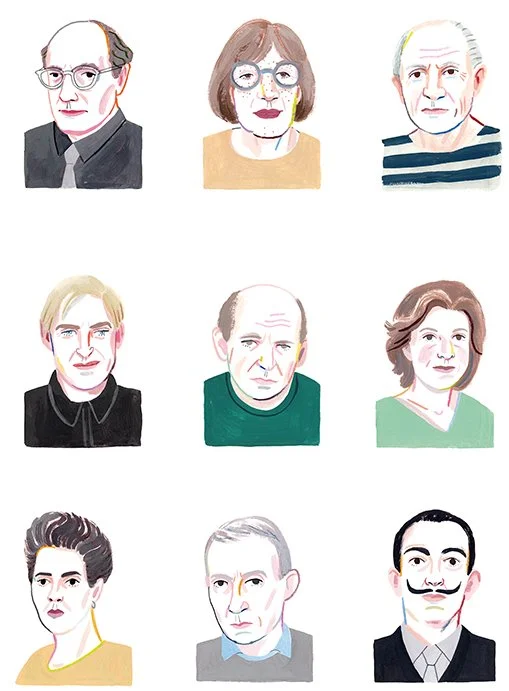A artista americana tem como marca registrada as elegantes e bem-humoradas ilustrações aquareladas e os retratos com alma de pintura de nomes que vão de Picasso a Grace Coddington, feitos sob encomenda para jornais, revistas e marcas de moda
Quem são suas maiores influências?
No começo, me inspirava muito em Henri Matisse e David Hockney. Hoje em dia, me inspiro em designers de moda e interiores, e em alguns amigos também artistas, como Marie Assenat e B Milder.
Como você descreve sua arte?
Acho complicado chamar minhas ilustrações e retratos de arte, porque os faço sob encomenda, baseados em um assunto específico ou pessoas pré-determinadas. Todas as ilustrações são executadas à mão, com auxílio do computador e, atualmente, trabalho muito com retratos. Tenho tentado diversificar, criando outros tipos de desenhos, cerâmica, esculturas, enfim, experimentando novas formas de arte.
Você acha que ter morado na França e na Holanda influenciou o seu trabalho?
Acredito que o fato de ter estudado fora me influenciou de várias maneiras. Fui apresentada a diversas formas de arte, culinária e entretenimento. Ter experimentado a vida em tantos lugares me fez perceber o que, de fato, é universal, especialmente na vida em sociedade. Me tornei uma pessoa muito mais curiosa, ansiosa por novas descobertas. Senti que, após oito anos fora dos Estados Unidos, retornei a Nova York me sentindo um pouco estrangeira, apesar de ter sido muito bem recebida. Mas esse sentimento não é algo novo para mim. As constantes mudanças me fizeram aprender a observar, incorporando novos costumes e perspectivas, o que sempre me faz crescer.
O que muda ao criar produtos tão diferentes para marcas que vão das ilustrações para o The New York Times e I-D Magazine aos lindos retratos de artistas para o jogo de cartas da Laurence King Publishing?
Meu processo criativo geralmente é o mesmo. Para o Times tenho que ser rápida, pois tenho pouco tempo para dúvidas ou re exões. Trabalho com grandes diretores de arte que me ajudam a produzir excelentes resultados e, ainda assim, cumprir prazos apertados. Só o tamanho da ilustração é que influencia bastante meu modo de trabalhar e gerenciar o tempo. Gosto de desenhar e/ou pintar de acordo com o tamanho da gura a ser publicada.
Qual é o seu trabalho próprio favorito?
Essa pergunta é difícil. Não sei dizer. Tenho a sorte de ter muitos clientes com os quais trabalho há anos, e acho interessante ver como meu estilo tem evoluído com o tempo, como por exemplo, o Longwood Gardens na Pensilvânia, ou o Metropolitan Museum. The Artist Card Game para Laurence King é minha série mais recente, e estou apaixonada por ela.
Para onde gosta de ir quando precisa de inspiração?
Tenho alguns livros de arte em casa, que busco quando preciso me inspirar. Também gosto de ir a museus, usar o Instagram ou o Pinterest. Sempre encontro expressões ou fotos de animais que me motivam, gosto da imprevisibilidade das redes sociais. Ouço muita música, mas não procuro nada específico, me deixo levar e vejo o que acontece.
Como é o processo de criação dos seus retratos? Usa técnicas similares às da pintura?
Retratos são mais fáceis do que as ilustrações editoriais. Penso menos, observo mais. Eu raramente desenho a partir de modelos vivos e, quando desenho, é por diversão, não por encomenda. A técnica é a mesma usada em pinturas em geral.
Qual foi a primeira obra de arte que causou impacto em você?
Quando era pequena, minha mãe enquadrou algumas pinturas que eu tinha feito aos 4 anos de idade. Lembro de ter ficado muito orgulhosa e satisfeita por isso.
Como a arte pode mudar o mundo?
Acredito que a arte é capaz de mudar o mundo ao nos tornar mais flexíveis. Ela nos faz enxergar e compreender o mundo por meio da perspectiva do outro. Como artista, você pode escolher destacar aspectos que são importantes para você, engajar outras pessoas e, quem sabe, fazê-las sorrir. Isso é muito importante para mim.
Quais são seus materiais de trabalho favoritos quando está criando?
Lápis de cor e guache. Atualmente, tenho usado muito.
